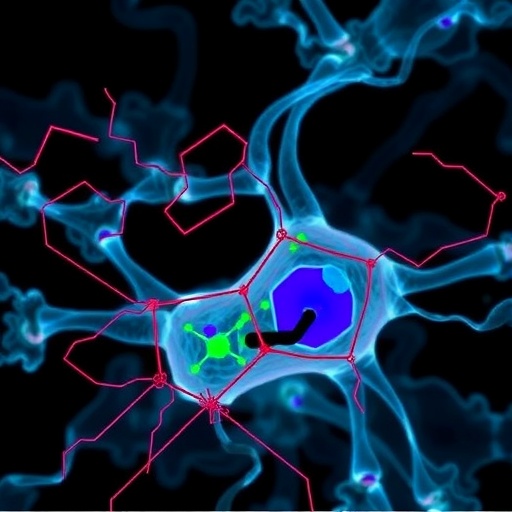In a groundbreaking study that could reshape our understanding of treatment-resistant depression, researchers have mapped the in vivo distribution of serotonin 1A (5-HT1A) receptors in patients unresponsive to conventional therapies. This pioneering work sheds unprecedented light on the molecular underpinnings of one of psychiatry’s most confounding clinical challenges. Using advanced neuroimaging modalities, the research team elucidated distinct receptor patterns that may explain why some individuals fail to benefit from standard antidepressant regimens, holding promise for more targeted, effective interventions.
The endeavor to decode treatment-resistant depression is not new, but this effort delves into the intricate serotonergic system with a precision previously unattainable. Serotonin 1A receptors, pivotal in modulating mood and emotional regulation, have long been suspected of playing a critical role in depressive disorders. Prior studies have hinted at anomalies in their function or expression, yet until now, a comprehensive live mapping in patients resistant to treatment was missing. This study bridges that crucial gap, leveraging state-of-the-art positron emission tomography (PET) imaging to quantify receptor availability throughout the brain, enabling direct comparisons between resistant patients and healthy controls.
Central to the methodology is the use of highly selective radioligands that bind exclusively to 5-HT1A receptors, allowing visualization with remarkable specificity. By administering these tracers to participants, the researchers captured real-time receptor distribution, enabling the distinction of subtle variations that could influence neurotransmission. The imaging data was meticulously analyzed using sophisticated modeling techniques to produce accurate receptor density maps, facilitating a nuanced understanding of regional differences implicated in depressive pathology.
One striking revelation was the altered receptor density observed in limbic system structures, particularly the hippocampus and amygdala, regions classic for their involvement in emotional processing and stress response. Patients with treatment-resistant depression displayed significantly diminished 5-HT1A receptor binding in these areas compared to both treatment-responsive individuals and healthy controls. This receptor deficit may correlate with impaired serotonergic signaling, thereby contributing to the persistence of depressive symptoms despite pharmacological intervention.
Equally compelling was the finding of abnormal receptor distribution in the prefrontal cortex, a region integral to executive function and regulation of mood. The study detected heterogeneity in receptor expression within subregions of the prefrontal cortex, suggesting localized dysfunction. Such patterns could underlie deficits in cognitive flexibility and emotional regulation frequently reported in treatment-resistant depression, highlighting the intricate neurobiological networks sustaining this condition.
Beyond receptor localization, the team explored the dynamic interactions between 5-HT1A receptors and other neurotransmitter systems, uncovering evidence of compensatory mechanisms. For example, alterations in receptor density appeared to coincide with changes in dopaminergic and glutamatergic activity, pointing to a complex neurochemical interplay underpinning resistance to treatment. This multifaceted perspective reframes treatment-resistant depression as a disorder of interconnected neural circuits rather than isolated neurotransmitter deficits.
The study’s longitudinal design added further depth, tracking receptor alterations over months in patients undergoing alternative therapeutic strategies. Notably, some interventions aimed at modulating serotonergic function succeeded in partially normalizing receptor distributions, correlating with clinically meaningful improvements. These observations pave the way for personalized medicine approaches, where receptor mapping could guide the selection of therapies tailored to individual receptor profiles, maximizing efficacy and minimizing side effects.
Critically, this research underscores the limitations of current antidepressants, which predominantly target serotonin reuptake but may not adequately address receptor-level pathology. The clear dissociation between drug action and receptor availability in treatment-resistant patients compels the psychiatric community to rethink therapeutic paradigms, advocating for novel agents capable of directly modulating receptor activity or promoting receptor recovery.
The repercussions extend into biomarker discovery, with 5-HT1A receptor mapping emerging as a promising candidate for diagnostic and prognostic tools. Quantitative imaging could stratify patients based on receptor profiles, predicting treatment response and disease trajectory. Furthermore, this approach could aid in monitoring therapeutic efficacy, providing objective measures to refine clinical decisions.
While the study is a monumental advance, it also opens new avenues of inquiry. The causal relationship between receptor distribution and treatment resistance remains to be fully elucidated. Are receptor changes a consequence of chronic depression or a predisposing factor? Investigating this question will require integration of genetic, epigenetic, and environmental data to chart the developmental trajectory of receptor alterations.
Moreover, the implications extend beyond depression, as 5-HT1A receptors are implicated in anxiety, psychosis, and neurodegenerative diseases. Understanding receptor dynamics in treatment resistance across psychiatric disorders may unveil universal principles, fostering cross-disciplinary therapeutic innovations. The scalability of imaging protocols across populations and healthcare settings will determine the translational potential of these findings.
Collaborative efforts integrating neuroimaging, pharmacology, and computational neuroscience are essential to harness the full promise of this research. As the field embraces increasingly precise molecular psychiatry tools, the hope is to transform depression from a heterogeneous diagnosis into a constellation of biologically defined subtypes, facilitating curative treatments rather than symptomatic relief.
In sum, the study presents a compelling narrative of how cutting-edge imaging technology redefines our conception of treatment-resistant depression. By illuminating the elusive serotonergic receptor architecture, it opens the door to targeted interventions tailored to the unique neurochemical landscapes of individuals. This paradigm shift heralds a future where depression treatment is informed by molecular signatures, improving outcomes and rekindling hope for millions worldwide.
The journey from receptor mapping to therapeutic breakthroughs is just beginning, embodying the essence of precision medicine in psychiatry. Researchers and clinicians alike stand poised to translate these insights into clinical realities, forging new paths in our quest to conquer one of the most pervasive mental health challenges of our time.
Subject of Research: In vivo mapping of serotonin 1A receptor distribution in treatment-resistant depression.
Article Title: In vivo serotonin 1A receptor distribution in treatment-resistant depression.
Article References:
Murgaš, M., Milz, C., Stöhrmann, P. et al. In vivo serotonin 1A receptor distribution in treatment-resistant depression. Transl Psychiatry 15, 186 (2025). https://doi.org/10.1038/s41398-025-03406-3
Image Credits: AI Generated




